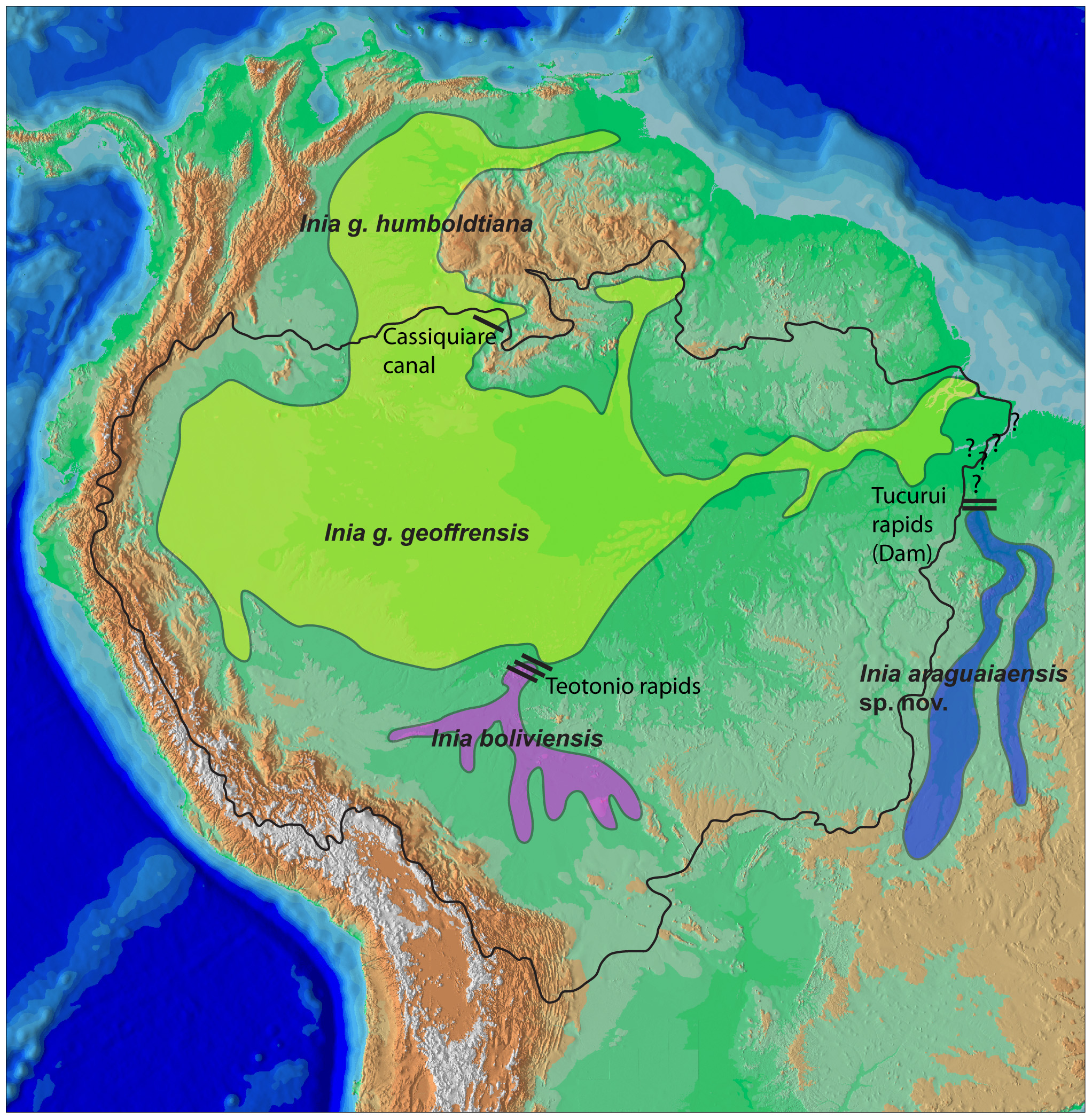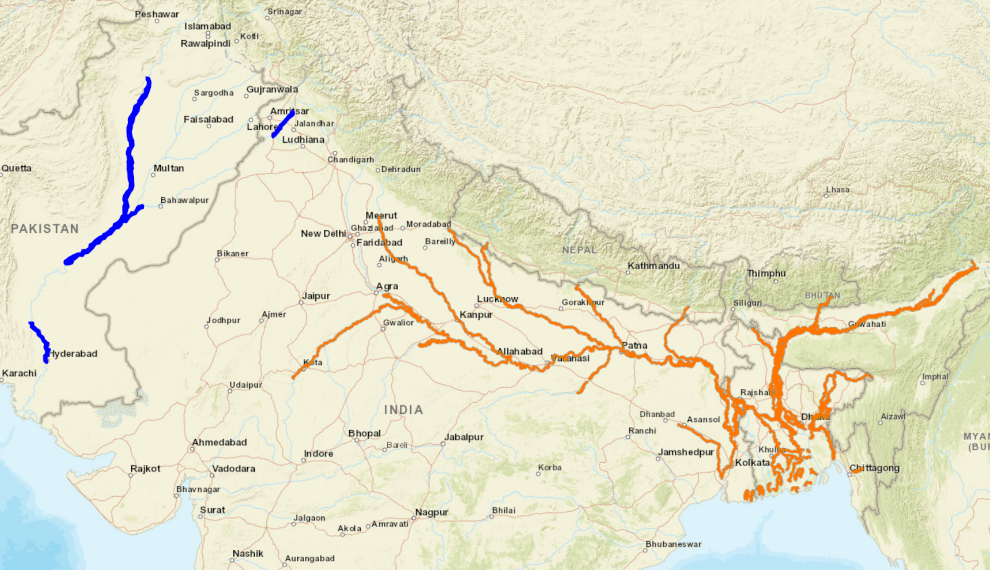|
Bolivian River Dolphin
The Bolivian river dolphin is a species (''Inia boliviensis'') or subspecies (''Inia geoffrensis boliviensis'') of freshwater dolphin found in upstream areas of the Amazon Basin. Taxonomy Bolivian river dolphins were discovered by the Western world in 1832 by French researcher Alcide d'Orbigny. The Bolivian river dolphin was briefly thought to be a subspecies (as ''I. geoffrensis boliviensis)'' of the Amazonian river dolphin, ''Inia geoffrensis'', but differences in body structure and the isolation of the Bolivian river dolphin led to it being classified as its own species in 2012. In a study conducted in 2015, it was also noted that any gene flow between ''I. geoffrensis'' (downstream) and ''I. boliviensis'' (upstream) would be a one way path flowing from upstream to downstream due to the Teotônio waterfall between them. Despite any gene flow, these populations would also remain morphologically different from each other due to the differences in the environment ... [...More Info...] [...Related Items...] OR: [Wikipedia] [Google] [Baidu] |
Alcide D'Orbigny
Alcide Charles Victor Marie Dessalines d'Orbigny (6 September 1802 – 30 June 1857) was a French naturalist who made major contributions in many areas, including zoology (including malacology), palaeontology, geology, archaeology and anthropology. D'Orbigny was born in Couëron (Loire-Atlantique), the son of a ship's physician and amateur naturalist. The family moved to La Rochelle in 1820, where his interest in natural history was developed while studying the marine fauna and especially the microscopic creatures that he named "foraminiferans". In Paris he became a disciple of the geologist Louis Cordier, Pierre Louis Antoine Cordier (1777–1861) and Georges Cuvier. All his life, he would follow the theory of Cuvier and stay opposed to Lamarckism. South American era D'Orbigny travelled on a mission for the Paris Museum, in South America between 1826 and 1833. He visited Venezuela, Colombia, Ecuador, Peru, Bolivia, Chile, Argentina, Paraguay, and Brazil, and returned to Franc ... [...More Info...] [...Related Items...] OR: [Wikipedia] [Google] [Baidu] |
River Dolphin
River dolphins are a polyphyletic group of fully aquatic mammals that reside exclusively in freshwater or brackish water. They are an informal grouping of dolphins, which itself is a paraphyletic group within the infraorder Cetacea. Extant river dolphins are placed in two superfamilies, Platanistoidea and Inioidea. They comprise the families Platanistidae (the South Asian dolphins), the possibly extinct Lipotidae (Yangtze River dolphin), Iniidae (the Amazonian dolphins) and Pontoporiidae. There are five extant species of river dolphins. River dolphins, alongside other cetaceans, belong to the clade Artiodactyla, with even-toed ungulates, and their closest living relatives the hippopotamuses, from which they diverged about 40 million years ago. Specific types of dolphins can be pink. River dolphins are relatively small compared to other dolphins, having evolved to survive in warm, shallow water and strong river currents. They range in size from the long South Asian river dol ... [...More Info...] [...Related Items...] OR: [Wikipedia] [Google] [Baidu] |
Mammals Of Bolivia
A mammal () is a vertebrate animal of the class Mammalia (). Mammals are characterised by the presence of milk-producing mammary glands for feeding their young, a broad neocortex region of the brain, fur or hair, and three middle ear bones. These characteristics distinguish them from reptiles and birds, from which their ancestors diverged in the Carboniferous Period over 300 million years ago. Around 6,640 extant species of mammals have been described and divided into 27 orders. The study of mammals is called mammalogy. The largest orders of mammals, by number of species, are the rodents, bats, and eulipotyphlans (including hedgehogs, moles and shrews). The next three are the primates (including humans, monkeys and lemurs), the even-toed ungulates (including pigs, camels, and whales), and the Carnivora (including cats, dogs, and seals). Mammals are the only living members of Synapsida; this clade, together with Sauropsida (reptiles and birds), constitutes ... [...More Info...] [...Related Items...] OR: [Wikipedia] [Google] [Baidu] |
Inia
''Inia'' is a genus of river dolphins from South America, containing one to four species. Taxonomy The genus was described by Alcide d'Orbigny in 1834 when ''Delphinus geoffrensis'', described by Henri Marie Ducrotay de Blainville in 1817, was recognized to be a unique taxon. D'Orbigny also described ''Inia boliviensis'' as type species of the genus. A 1998 classification listed a single species, ''Inia geoffrensis'', in the genus ''Inia'', with three recognized subspecies. Most of the scientific community accepted this single species classification, as does the IUCN. As of 2016 the Committee on Taxonomy of the Society for Marine Mammalogy considers the genus ''Inia'' to contain one species with only two subspecies: the Bolivian (''I. g. boliviensis'') and the Amazon (''I. g. geoffrensis)'' subspecies. In 2014, the population in the Araguaia-Tocantins basin was proposed to define an additional species, ''Inia araguaiaensis'', but this remains debated. The American Society of Ma ... [...More Info...] [...Related Items...] OR: [Wikipedia] [Google] [Baidu] |
BBC News
BBC News is an operational business division of the British Broadcasting Corporation (BBC) responsible for the gathering and broadcasting of news and current affairs in the UK and around the world. The department is the world's largest broadcast news organisation and generates about 120 hours of radio and television output each day, as well as online news coverage. The service has over 5,500 journalists working across its output including in 50 foreign news bureaus where more than 250 foreign correspondents are stationed. Deborah Turness has been the CEO of news and current affairs since September 2022. In 2019, it was reported in an Ofcom report that the BBC spent £136m on news during the period April 2018 to March 2019. BBC News' domestic, global and online news divisions are housed within the largest live newsroom in Europe, in Broadcasting House in central London. Parliamentary coverage is produced and broadcast from studios in London. Through BBC English Regions, th ... [...More Info...] [...Related Items...] OR: [Wikipedia] [Google] [Baidu] |
List Of Cetacean Species
Cetacea is an infraorder that comprises the 94 species of whales, dolphins, and porpoises. It is divided into toothed whales (Odontoceti) and baleen whales (Mysticeti), which diverged from each other in the Eocene some 50 mya (unit), million years ago (mya). Cetaceans are descended from land-dwelling hoofed mammals, and the now extinct archaeocetes represent the several transitional phases from terrestrial to completely aquatic. Historically, cetaceans were thought to have descended from the wolf-like Mesonychia, mesonychians, but cladistic analyses confirm their placement with even-toed ungulates in the order Cetartiodactyla. Whale populations were drastically reduced in the 20th century from intensive whaling, which led to a moratorium on hunting by the International Whaling Commission in 1982. Smaller cetaceans are at risk of accidentally getting caught by fishing vessels using, namely, seine fishing, drift netting, or gill netting operations. Conventions The following is ... [...More Info...] [...Related Items...] OR: [Wikipedia] [Google] [Baidu] |
River Dolphins
River dolphins are a polyphyletic group of fully aquatic mammals that reside exclusively in freshwater or brackish water. They are an informal grouping of dolphins, which itself is a paraphyletic group within the infraorder Cetacea. Extant river dolphins are placed in two superfamilies, Platanistoidea and Inioidea. They comprise the families Platanistidae (the South Asian dolphins), the possibly extinct Lipotidae (Yangtze River dolphin), Iniidae (the Amazonian dolphins) and Pontoporiidae. There are five extant species of river dolphins. River dolphins, alongside other cetaceans, belong to the clade Artiodactyla, with even-toed ungulates, and their closest living relatives the hippopotamuses, from which they diverged about 40 million years ago. Specific types of dolphins can be pink. River dolphins are relatively small compared to other dolphins, having evolved to survive in warm, shallow water and strong river currents. They range in size from the long South Asian river dolphi ... [...More Info...] [...Related Items...] OR: [Wikipedia] [Google] [Baidu] |
Eunectes Beniensis
''Eunectes beniensis'' is a boa species known only from the northeastern parts of Bolivia. Its common names, the Bolivian anaconda and Beni anaconda, are derived from the geographic location of its native habitat: the Beni area of Bolivia. Like all boas, it is nonvenomous. Description ''Eunectes beniensis'' is a species of boa, reaching between in length and can weigh up to . It was initially believed to be the result of hybridization between the green (''Eunectes murinus The green anaconda (''Eunectes murinus''), also known as the giant anaconda, emerald anaconda, common anaconda, common water boa, or southern green anaconda, is a semi-aquatic Boinae, boa species found in South America and the Caribbean island ...'') and yellow anaconda ('' Eunectes notaeus''), but was later determined to be a distinct species. Its taxonomic status is unclear due to lack of information and the similarity in appearance to ''Eunectes notaeus''. It is closely related to ''Eunectes notaeus'' ... [...More Info...] [...Related Items...] OR: [Wikipedia] [Google] [Baidu] |
Tijamuchi River
The Tijamuchi River is a river of Bolivia, located in the Beni department. It is known for its significant river dolphin (''Inia geoffrensis'') population.*Rand McNally, The New International Atlas, 1993. See also *List of rivers of Bolivia This is a list of rivers in Bolivia. By drainage basin This list is arranged by drainage basin, with respective tributaries indented under each larger stream's name. Rivers longer than are in bold. Rivers that reach the ocean Amazon Basin ** M ... References Rivers of Beni Department {{Bolivia-river-stub ... [...More Info...] [...Related Items...] OR: [Wikipedia] [Google] [Baidu] |
Inia De Bolivie
''Inia'' is a genus of river dolphins from South America, containing one to four species. Taxonomy The genus was described by Alcide d'Orbigny in 1834 when ''Delphinus geoffrensis'', described by Henri Marie Ducrotay de Blainville in 1817, was recognized to be a unique taxon. D'Orbigny also described ''Inia boliviensis'' as type species of the genus. A 1998 classification listed a single species, ''Inia geoffrensis'', in the genus ''Inia'', with three recognized subspecies. Most of the scientific community accepted this single species classification, as does the IUCN. As of 2016 the Committee on Taxonomy of the Society for Marine Mammalogy considers the genus ''Inia'' to contain one species with only two subspecies: the Bolivian (''I. g. boliviensis'') and the Amazon (''I. g. geoffrensis)'' subspecies. In 2014, the population in the Araguaia-Tocantins basin was proposed to define an additional species, ''Inia araguaiaensis'', but this remains debated. The American Society of Ma ... [...More Info...] [...Related Items...] OR: [Wikipedia] [Google] [Baidu] |
Orinoco River
The Orinoco () is one of the longest rivers in South America at . Its drainage basin, sometimes known as the Orinoquia, covers approximately 1 million km2, with 65% of it in Venezuela and 35% in Colombia. It is the List of rivers by discharge, fourth largest river in the world by Discharge (hydrology), discharge volume of water (39,000 m3/s at Orinoco Delta, delta) due to the high precipitation throughout its catchment area (ca 2,300 mm/a). The Orinoco River and its tributaries are the major transportation system for eastern and interior Venezuela and the Llanos of Colombia. The environment and wildlife in the Orinoco's basin are extremely diverse. Etymology The river's name is derived from the Warao language, Warao term for "a place to paddle", itself derived from the terms ''güiri'' (paddle) and ''noko'' (place) i.e. a navigable place. History The mouth of the Orinoco River at the Atlantic Ocean was documented by Christopher Columbus on 1 August 1498, during his Christo ... [...More Info...] [...Related Items...] OR: [Wikipedia] [Google] [Baidu] |







